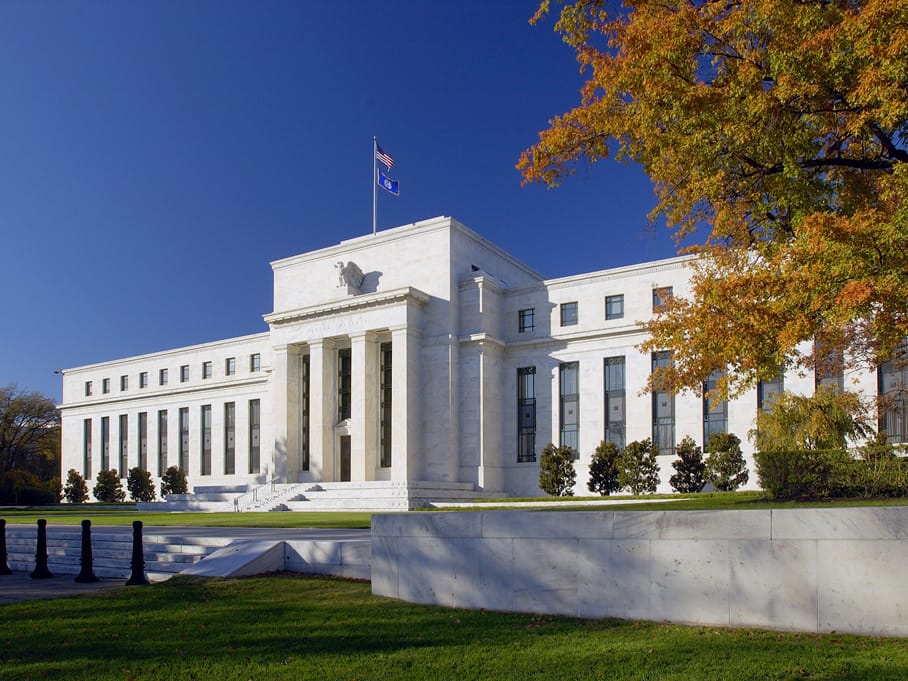Earlier today, the US CPI inflation data came in lower than expected, with all eyes fixed on the FOMC to see whether these latest data might change the outlook for interest rate cuts. We now know that they decided to keep rates at current levels but market watchers are now fully focused on trying to work out when – if at all this year- US interest rates will start to fall.
Commenting on today’s FOMC decision, Salman Ahmed, Global Head of Macro & Strategic Asset Allocation at Fidelity International comments: “As expected, the Fed kept rates unchanged. However, the latest dot plot showed only one cut in 2024 versus the previous three. This was lower than the market consensus of two cuts. Despite today’s better than expected CPI release, the Fed seems to be taking a cautious stance on signalling the future policy path.
“The press conference was more open-ended, with Chair Powell emphasising the importance of incoming data flow, especially on the inflation front. We have seen the Fed completely abandon any kind of reliance on forecasting to set policy, so we continue to foresee the current data dependency in policy and markets to remain in place.
“Our base case is zero cuts this year but if progress on inflation continues over the summer months or labour markets starts to show some signs of stress, we do see the likelihood of one cut this year rising. That said, the US economy remains resilience and today’s release was affected by vehicle insurance and airfare components, which means the bar for cutting to start remains high.”
Nick Chatters, fixed income manager at Aegon Asset Management said: “The interesting nuance was that whilst the SEP is showing one cut this year, the risks between one and two are more balanced than that. Most FOMC members didn’t update their DOT to take account of the CPI print, so given that the split between one and two is already very close, could we see a September start? If we do, then surely December must be in play. As always, the data will tell.
“From the statement the key line is as follows: ‘In recent months, there has been modest further progress toward the Committee’s 2 percent inflation objective’. So, modest further progress now, as opposed to needing to see further progress, which was the line at the past meeting – the Fed is starting to believe!
“The median of the committee now expects one cut this year, with four cuts in 2025 and another four in 2026. The longer run DOT, which is a proxy for the Fed’s neutral rate (although they wont admit that), was also revised up to 2.8%.”
Following today’s US Fed interest rate decision and US inflation data, Isabel Albarran, Investment Officer at Close Brothers Asset Management, said:
“Today’s decision by the Fed to keep interest rates at a 23-year high of 5.25-5.5% was unsurprising but recent market moves, pushing out the timing of the first cut as far as December could be an overreaction. Nonetheless, the new dot plot does signal that FOMC participants only expect to cut very modestly this year.
“The statement does suggest greater optimism from the Fed on inflation. The wording hasn’t changed much but “a lack of progress” has been upgraded to “modest progress”. While survey data remains resilient, wage and price data has been coming in softer since the Fed’s last meeting, albeit the pace of slowing has been stop-start. Today’s CPI print supports this softer trend, with headline inflation falling to 3.3% in May, from 3.4% the previous month. April CPI also cooled, and April PCE was at least in-line with forecasts. While Friday’s labour market print for May showed a re-acceleration in non-farm payrolls and wage growth, the household survey painted a picture of much greater softness. We think this is due to higher immigration relieving tightness in the labour market, which isn’t being reflected in the household survey.
“With the first cut now priced for November, how the labour market data evolves is crucial in determining the Fed’s next steps. With the Fed in data dependent mode, a cut this year will require further progress.”
James McCann, Deputy Chief Economist, abrdn said; “The Fed unsurprisingly left policy unchanged but continues to just about keep the door open to rate cuts this year. Indeed, the median FOMC member is now forecasting just one rate cut in 2024, compared to the three they had penciled in back in March. This hawkish shift was likely in reaction to stronger than expected price growth in early 2024, which forced committee members to revise their inflation forecasts higher once again. However, today’s downside surprise in CPI inflation was more encouraging, and with most members split between one or two cuts we wouldn’t be surprised to see market pricing continue to flirt with multiple rate cuts this year.”
Richard Carter, head of fixed interest research at Quilter Cheviot said: “With the US stuck in a holding pattern, waiting for either inflation to fall more quickly towards its 2% target or for the economy to buckle under the strain, the Federal Reserve has once again opted to keep rates on hold.
“This morning’s inflation print showed that though inflation declined, it fell only marginally and remains too hot to allow for a rate cut just yet. Nonetheless, markets have continued to speculate on when the first rate cut will materialise. The Fed’s latest dot plot has helped paint a clearer picture of the expected path ahead for the remainder of this year, with just one cut now anticipated before the end of 2024 down from three previously.
“There remain a great deal of unknowns for the Fed, and it will continue to keep a close eye on the data ahead of its next FOMC meeting. For now, GDP growth is weakening, inflation has a way to go before it hits target, and the labour market is showing mixed signals, so its decision-making process is unlikely to be made easier any time soon. What’s more, the upcoming election campaign could further affect the Fed’s thinking, though history suggests that if the economy were to demand it, the Fed would continue to act regardless.
“Ultimately, though the Fed still appears to be heading closer to its first rate cut, it will no doubt tread carefully for fear of cutting too much too quickly which could prove disastrous. The European Central Bank might have fired the starting gun last week but the Fed has not been so quick off the mark, and the Bank of England is unlikely to be either.”
Daniele Antonucci, Chief Investment Officer at Quintet Private Bank (parent of Brown Shipley) on U.S Fed Decision said: “Anticipating whether the Fed will signal just one or two rate cuts this year was always a close call. And the committee, reflecting multiple views, does present quite a bit of variation in the members’ indications.
“The key thing here is that, while inflation has made some modest progress towards the central bank’s objective, the Fed believes this isn’t enough. And it’s not just inflation. The U.S economy might well be slowing, but it keeps creating a lot of jobs, with the unemployment rate at multi-decade lows and solid wage growth.
“All of this is a hurdle for the Fed to cut rates in the near future, regardless of whether the central bank manages to reduce the Fed funds rate once or even twice at year-end or, perhaps guided by continued resilience in the data, at the start of next year. At the margin, this hawkish shift does increase the odds that the US economy slows more markedly.
“Said differently, economic resilience is delaying the Fed rate cutting cycle. But the longer rates stay elevated, the more likely it is economic growth and inflation will slow, eventually allowing the central bank to start its rate cutting cycle. This is why, looking six months further out, we think it’s probable that conditions would be there for the central bank to begin to cut.
“However, there’s still significant uncertainty around the timing and, for now, we think the Fed will likely maintain that, while inflation is moderating, more evidence is needed to reduce rates.”















